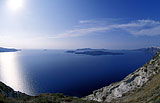
View of the 13x8km large caldera of Santorini, Greece,
formed during several Plinian eruptions including
the Minoan eruption around 1645 BC.
THEMATIC VOLCANO PHOTO GALLERY:
- Caldera -

View of the 13x8km large caldera of Santorini,
Greece,
formed during several Plinian eruptions including
the Minoan eruption around
1645 BC.
|
Brief explanation:
A caldera is a large, usually circular depression at the summit of a
volcano formed when magma is withdrawn or erupted from a shallow
underground magma reservoir. The removal of large volumes of magma may
result in loss of structural support for the overlying rock, thereby
leading to collapse of the ground and formation of a large depression.
Calderas are different from craters, which are smaller, circular
depressions created primarily by explosive excavation of rock during
eruptions. (From
USGS Photoglossary). |
|
 |
�raefaj�kull volcano, SE-Iceland. The summit caldera of this large, explosive volcano that erupted last in 1728, is occupied by a glacier, which is part of the Vatnaj�kull ice cap that covers most of SE Iceland. |
 |
Tengger caldera, Java, Indonesia. This complex 16-km-wide caldera is located north of Semeru volcano and dates back to about 820,000 years ago. It consists of five overlapping stratovolcanoes, each truncated by a caldera. Lava domes, pyroclastic cones, and a maar occupy the flanks of the massif. The most recent of the Tengger calderas is the 9 x 10 km wide Sandsea caldera at the SW end of the complex, which formed incrementally during the last ca. 10,000 years. An overlapping cluster of post-caldera cones formed on the caldera-floor within the past several thousand years. The youngest of these is Bromo, one of Java's most active volcanoes. (Abbreviated from: GVP). |
 |
Aniakchak Caldera, Alaska, formed during an enormous explosive eruption that expelled more than 50 km3 of magma about 3,450 years ago. The caldera is 10 km in diameter and 500-1,000 m deep. Subsequent eruptions formed domes, cinder cones, and explosion pits on the caldera floor. (Photograph by M. Williams, National Park Service, 1977; courtesy of USGS) |
 |
Mauna Loa Volcano, Hawai`i. Snow-covered Moku`aweoweo Caldera atop Mauna Loa shield volcano (Mauna Kea in background). The caldera is 3 x 5 km across, 183 m deep, and is estimated to have collapsed between 600-750 years ago. Several pit craters along the upper southwest rift zone of Mauna Loa (lower right) also formed by collapse of the ground. For more information about the world's largest volcano, see Mauna Loa Volcano from the USGS Hawaiian Volcano Observatory. (Photograph by D.W. Peterson; courtesy of USGS). |
|
Ugashik volcano, Alaska. Aerial view, looking southwest, of Ugashik caldera. The caldera is 5 km in diameter and is partially filled by at least five lava domes erupted after the caldera formed. (Photograph by B. Yount on April 11, 1984; courtesy of USGS). |
|
 |
Crater Lake, Oregon. Crater Lake partially fills an 8-10 km-wide caldera that formed when the top of the Cascade volcano known as Mount Mazama collapsed during an enormous explosive eruption about 7,700 years ago. The eruption expelled about 50 km3 of magma. This cataclysmic event was followed by a series of post-caldera eruptions until about 5,000 years ago. These smaller events erupted lava flows, a lava dome, and tephra from vents on the caldera floor. Such activity built Wizard Island (above) on the western caldera floor. A 1997 report describes the various types of volcano and earthquake hazards in the Crater Lake area, estimates the likelihood of future events, suggests ways to reduce risk, and includes a map of hazard zones. (Photograph by D. Wieprecht on August 20, 1995; courtesy of USGS). |
 |
Kaguyak volcano, Alaska. This lake-filled caldera formed atop a former stratovolcano (note remnant of upper part of older cone at right center). The caldera formed about 1,100 years ago and is 2.5 km in diameter. The prominent peninsula and small island consists of lava domes erupted after the caldera formed. (Photograph by C. Neal on June 4, 1990; courtesy of USGS). |
|
Some interesting facts:
-- The largest eruption of the 20th century from the
Novarupta vent in the Valley of 10,000 Smokes of Alaska, ejected about 12
km3 of magma and resulted in the formation of a caldera 3 km
across. Amazingly, the caldera collapse didn't occur at the eruption vent,
but 10 km away at Katmai, a stratovolcano! Apparently magma drained away
from Katmai's magma reservoir to Novarupta's erupting vent. A few links to interesting internet sites regarding calderas: -
USGS documents
about calderas |
Copyright:
Before using text and photos of this page elsewhere please contact Tom Pfeiffer.
� Tom Pfeiffer, page set up on April 7, 2004.